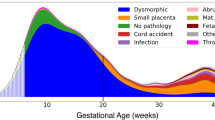Abstract
Objectives
This study examined the clinical significance of patients complicated by succenturiate lobes of placenta in comparison with patients with normal placenta.
Methods
Data were collected from 47 patients complicated by succenturiate lobes of placenta and from 7,666 unaffected controls.
Results
The frequency of maternal age ≥35 years and history of using in vitro fertilization in patients complicated by succenturiate lobes of placenta were significantly higher than those in control patients (P < 0.01). In addition, the incidence of non-reassuring fetal status, vasa previa, postpartum hemorrhage and retained placenta in the study group were significantly higher than those in control (P < 0.01).
Conclusion
These results support the adverse obstetric outcomes in pregnancies with succenturiate lobes of placenta and may suggest the pathogenesis of these placental shape aberrations associated with assisted reproductive technology.
Similar content being viewed by others
References
Benirschke K, Kaufmann P, Baergen RN (2006) Placental shape aberrations. In: Benirschke K, Kaufmann P, Baergen RN (eds) Pathology of the human placenta, 5th edn. Springer, New York, p 452
Chihara H, Otsubo Y, Ohta Y, Araki T (2000) Prenatal diagnosis of succenturiate lobes by ultrasonography and color Doppler imaging. Arch Gynecol Obstet 263:137–138
Cunningham FG, Leveno KJ, Bloom SL, Hauth JC, Gilstrap L, Wenstrom KD (2005) Placental abnormalities. In: Cunningham FG, Leveno KJ, Bloom SL, Hauth JC, Gilstrap L, Wenstrom KD (eds) Williams obstetrics, 22nd edn. McGraw Hill, New York, p 620
Hasegawa J, Matsuoka R, Ichizuka K, Fujikawa H, Sekizawa A, Okai T (2007) Umbilical cord insertion to the lower uterine segment is a risk factor for vasa previa. Fetal Diagn Ther 22:358–360
Hata K, Hata T, Aoki H, Takamori H, Takamiya O, Kitao M (1988) Succenturiate placenta diagnosed by ultrasound. Gynecol Obstet Invest 25:273–276
Kessler I, Lancet M, Borenstein R, Steinmetz A (1980) The problem of the older primipara. Obstet Gynecol 56:165–169
Lee W, Lee VL, Kirk JS, Sloan CT, Smith RS, Comstock CH (2000) Vasa previa: prenatal diagnosis, natural evolution, and clinical outcome. Obstet Gynecol 95:572–576
Naeye R (1983) Maternal age, obstetric complications, and the outcome of pregnancy. Obstet Gynecol 61:210–216
Oyelese KO, Schwärzler P, Coates S, Sanusi FA, Hamid R, Campbell S (1998) A strategy for reducing the mortality rate from vasa previa using transvaginal sonography with color Doppler. Ultrasound Obstet Gynecol 12:434–438
Oyelese Y, Catanzarite V, Prefuma F, Lashley S, Schachter M, Tovbin Y, Goldstein V, Smulian JG (2004) Vasa previa: the impact of prenatal diagnosis on outcomes. Obstet Gynecol 103:937–942
Shevell T, Malone FD, Vidaver J, Porter TF, Luthy DA, Comstock CH, Hankins GD, Eddleman K, Dolan S, Dugoff L, Craigo S, Timor IE, Carr SR, Wolfe HM, Bianchi DW, D’Alton ME (2005) Assisted reproductive technology and pregnancy outcome. Obstet Gynecol 106:1039–1045
Shukunami K, Tsunezaki W, Hosokawa K, Tajima K, Kotsuji F (2002) Placental previa of a succenturiate lobe: a report of two cases. Eur J Obstet Gynecol Reprod Biol 99:276–277
Author information
Authors and Affiliations
Corresponding author
Rights and permissions
About this article
Cite this article
Suzuki, S., Igarashi, M. Clinical significance of pregnancies with succenturiate lobes of placenta. Arch Gynecol Obstet 277, 299–301 (2008). https://doi.org/10.1007/s00404-007-0482-6
Received:
Accepted:
Published:
Issue Date:
DOI: https://doi.org/10.1007/s00404-007-0482-6




